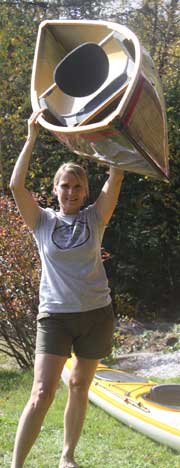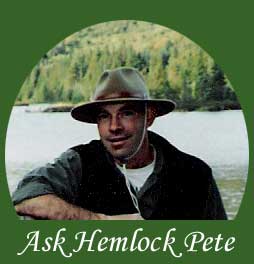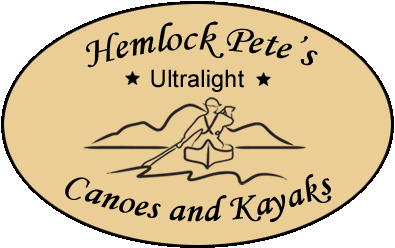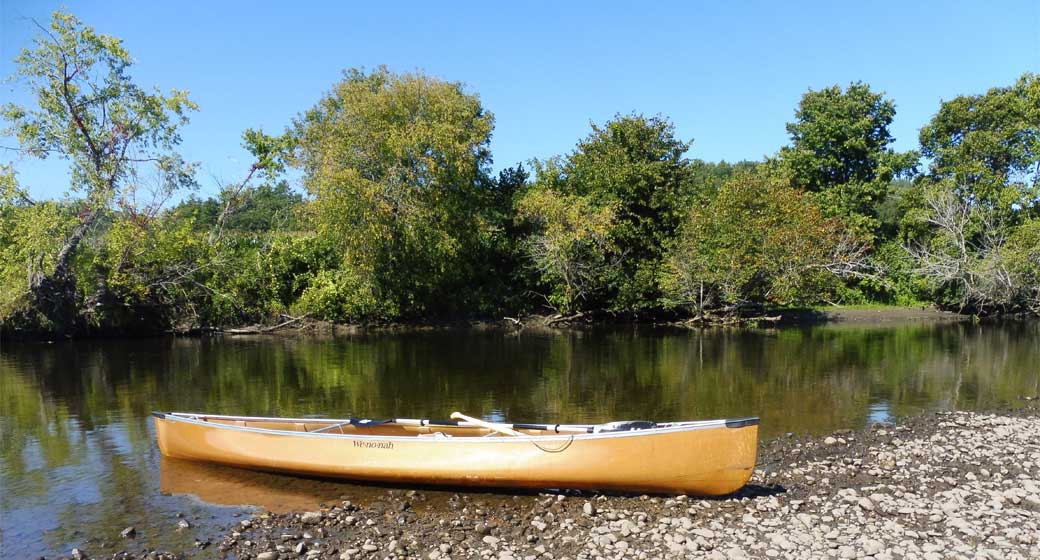




![]() Ultralight boats!
Ultralight boats!
Hull Design
When we talk about canoes, how many of us really know how they perform
and why? What is the difference between a straight or rockered keel line?
Should I buy a flat bottom or shallow arch? Do I want flair or tumblehome?
If all this sounds confusing, take heart, it is not as difficult as it
seems. Canoes (like the wheel) have been around for a long time and while
improvements have been made, the basic design has not changed. Sit back
and relax while I briefly explain the basics of canoe design.
Lets look at the side profile of a canoe. The first item we are going to talk about is the keel line. This is the part of the hull shape that helps it go in a straight line (tracking) or allows it to turn. Take a look at diagram #1.
![]()
A straight keel line will help the canoe track on a straight course.
If it is rockered it will allow it to turn easier and it will have less
tendency to track. The more severe the rocker the quicker and easier it
will turn. Length also has an effect. Regardless of its keel profile a
longer canoe will track better than a shorter one of the same design.
Simply put, the more of the keel line that is in the water, the more turning
resistance there will be.
Next lets look at the shape of the bottom of the canoe. As a canoe moves through the water it literally must move water out of the way, pass through the void created, then replace the water behind itself. If this is not done efficiently, water builds up in front of the canoe. As this happens the bow tends to rise up and the stern sinks down. With the canoe in this position, you are actually paddling up a liquid hill, which is not the most efficient way to go about it. The shape of the canoe bottom determines how efficiently the waters are parted. There are two views we need to consider. The first being through the eyes of a fish looking up at a canoe on the surface. Symmetry. Take a look at diagram #2.

As you can see from the sketches a symmetrical hull is the
same at both ends where an asymmetrical hull is not. Most recreational
hulls are symmetrical. Asymmetrical hulls are generally found on higher
performance racing and touring canoes. Notice how much more distance there
is on the asymmetrical design from the point of the bow to its widest
point located on the stern side of its center. Also take note of how wide
the stern section is. The combination of the two allows the water to be
spread apart with minimal disruption and keeps the canoe level for optimum
efficiency. What we need to look at with either design are the entry and
exit lines. Taper. A canoe that is full (wide) will be more stable,
carry more weight and ride through rough water better than a narrow one.
However a canoe with narrower lines will be faster and take less energy
to paddle.
The second view of the canoe bottom is a cross-section of the part that actually sits in the water. There are several different shapes to choose from. Diagram #3 lays them out for us.

Before we discuss the different shapes lets go over some
related terminology. Initial stability, this refers to a canoe
that sits steady in the water and does not roll from side to side easily.
Secondary stability refers to a canoe that can be rolled from side
to side and back upright again with relative ease. Draft is how
deep it sits in the water and efficiency is how smoothly it moves through
the water. A flat bottom gives you excellent initial stability but generally
poor secondary stability. It does not draft much water generally requiring
just a few inches to float in. It is efficient a slower speeds but as
the speed increases the efficiency decreases. On the other end of the
scale a round bottom has poor initial stability and excellent secondary
stability. It will draft deeper than the flat bottom generally the deepest
of the 4 designs. It has poor efficiency at slow speed but as the speed
picks up it becomes more and more efficient. The shallow arch and shallow
"V" are somewhere in the middle. The length and width of the canoes come
into play here as well. Wider canoes spread out their weight more than
narrow ones therefore draft less water but they are also slower because
there is more canoe to move through the water. Likewise longer canoes
are faster than shorter ones of the same width because the length allows
more gradual entry and exit lines.
Finally we need to look at the sides of the canoe. Diagram #4 gives us yet another cross-sectional view. This time we will concern ourselves with the part above the water. I have exaggerated the drawings a little to highlight the differences between the three shapes.

A flair sided hull will tend to shed waves away from the
canoe as they ride up the side in rough seas and will ride up over waves
rather than cut through them. It acts somewhat like a wedge, spreading
the water outward away from the canoe. On the negative side it makes the
canoe wider thus requiring the paddler to reach out farther to paddle.
In contrast a straight-sided canoe will allow waves to travel straight
up its sides. Some of the water ends up in your lap and some back in the
lake. It will tend to cut through the waves rather than ride up over them.
Tumblehome and rough water do not mix. It literally guides waves into
the canoe. However it does have its place as it allows you to place your
paddle close to the hull when paddling which is the most efficient way
to do it. Something to consider along with this is the depth of the canoe
both in the center (amidships) and at the ends (bow and stern). The deeper
the canoe the more seaworthy it becomes in rough water. But the higher
sides give more area for the wind to grab hold of especially at the bow
and stern.
As you can see there are several things to consider when
choosing the hull design of a canoe. First decide how you will use it
and think about the conditions you will encounter (wind, waves, current,
etc.). Pick and choose from the options discussed above to suit your needs.
You may have to compromise on some but you can over come these with good
paddling technique.
When you have got it narrowed down or even if you do not, visit a reputable canoe shop and talk to them. Make sure you test paddle several of the designs you are interested in. If they won't let you paddle them, then find another dealer.
HAPPY PADDLING!!!

Have a question? I'm happy to answer it - just email me at hpcanoes@gmail.com
![]()
hpcanoes@gmail.com
603.667.5112

We specialize in ultralight solutions and offer expertise in canoes and Wee Lassie boats, as well as all the related equipment. Our favorites are Wenonah canoes and Wee Lassie boats. Although we will work with any material we like to get folks set up with lightweight canoes so you can dedicate your time to the joy of being out on the lakes and rivers instead of struggling to move your boat between car and water.
Scott Edwards, "Hemlock Pete" himself, offers you decades of paddling expertise. He is friendly, down-to-earth, and provides superior customer service. You won't find a better, or more pleasant, deal elsewhere.

